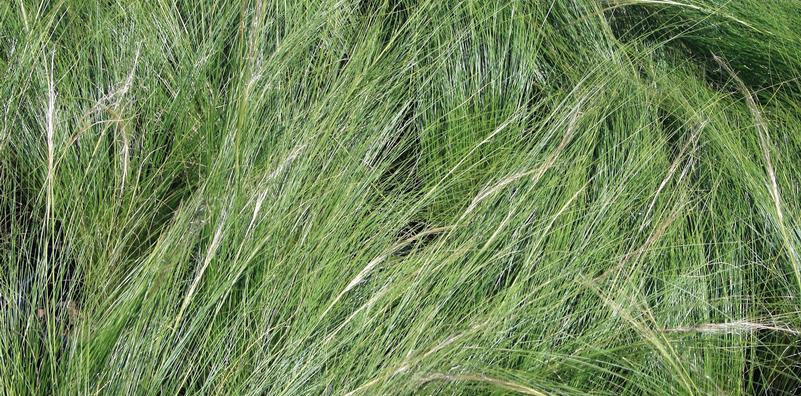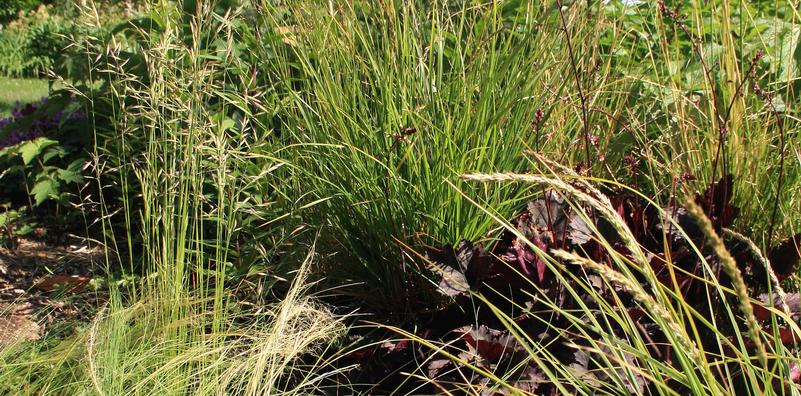Poetic Poaceae
Now that the magic of May has faded, with much of the springtime color we’ve come to enjoy around the nursery ending while we linger on the cusp of summer blooms, the time to celebrate the variances of green textures, tones, and shapes is upon us. We’ve talked before about the important ecological role that our Midwestern-American grasslands play in maintaining the balance of so many critically endangered mammalian and avian species. This week, we’re getting a little closer to home, talking more about the geographical, ecological, and, of course, ornamental properties of three strappy garden sidekicks (that hopefully after today will become more than just sidekicks in your installations).
For all intents and purposes, when we say “grasses”, this week we really do mean good ole true grasses – those belonging to the family Poaceae. We’ll get to the sedges and rushes of the world at a later date, but today we’re getting into the nodes and culms of it all.
On a large scale, grasses make up the most dominant biome worldwide, with grasslands serving as important habitats for the critters that live there and also aiding in erosion control and bioremediation in areas where soil has been degraded or disturbed. On a smaller, local scale, grasses provide a range of textures to the landscape, from their fine to strappy blades, and large-and-fluffy to delicate-and-mist-like inflorescences. This is evidenced in the finely textured, nearly hairlike leaves and stems of Nassella tenuissima, topped with threadlike inflorescences, which create a truly mesmerizing visual billowing in a soft summer breeze. Known commonly as Mexican feathergrass, this Southwestern native is stunning planted en masse in the rock garden, or mingling amongst brightly colored, boldly textured early summer blooms. The threadlike, silvery-white inflorescences gleam in the moonlight, providing an unexpected, fine texture in the nighttime garden. Its drought tolerance makes it a favorite of those with xeriscaping, and ability to self-seed readily in the landscape makes it a dutiful volunteer capable of filling in odd gaps where other plants may have difficulty establishing.
On the topic of grasses that are capable of establishing pretty much anywhere, Festuca rubra, creeping red fescue, is native not only to most of North America, but also much of the Northern Hemisphere worldwide. Its ability to handle a wide range of soil types, from rich, organic woodlands to dry, rocky, and even sandy coastal soils, makes it essentially a jack-of-all-trades for virtually any environment. The hardiness of Festuca rubra makes it suitable even for mowing and foot traffic, or when left alone, the loose panicles create a natural look and provide an upright element to the landscape with its soft, misty inflorescences that stand over 24” in height. Perhaps best known for its ability to tolerate shade better than other turfgrasses, creeping red fescue does best when provided at least light dappled shade, but will proliferate in both full sun to partial shade conditions. The summer dormancy period that Festuca rubra undergoes leaves room in the garden for warm season grasses and summer perennials to take the main stage. Looking for a shade-tolerant lawn alternative? Look no further than Festuca rubra.
If light shade is a consistent issue you’re dealing with in the landscape, and you desperately want to incorporate more grasses that won’t go dormant in the summer, Sesleria autumnalis is definitely one to consider. While some may consider the inflorescences to be less showy than that of the latter two species, others may argue that the erect, silvery-white blooms provide a modest textural contrast overtop of the yellow-green mound of foliage. Autumn moor grass, as this species is commonly known, is a wonderful semi-evergreen cool season grass that softens up garden bed or walkway edges, capable of handling drought-prone or polluted soils, and is no stranger to tolerating black walnut juglone. A mature, well-established Sesleria autumnalis specimen makes for a fantastic landscape filler or mounding, clumping groundcover in tricky partial shade areas. Alternatively, the inflorescences, which may be inconspicuous to some, are perfect child-height and have just the right amount of fluffiness to interest curious youngsters in the children’s or sensory garden, who are sure to want to run their tiny fingers through the blooms.
We’ve seen a huge demand for these grasses recently, so make sure to get your hands on them before they’re gone!
Nassella tenuissima | Mexican feathergrass
Festuca rubra | creeping red fescue
Sesleria autumnalis | Autumn moor grass
Festuca rubra (Red Fescue) (gardenia.net)
Sesleria autumnalis (Autumn Moor Grass) | North Carolina Extension Gardener Plant Toolbox (ncsu.edu)
Autumn moor grass | The Morton Arboretum
Sesleria autumnalis (autumn moor grass) - Lurie Garden
See all our Grasses
Nassella tenuissima

